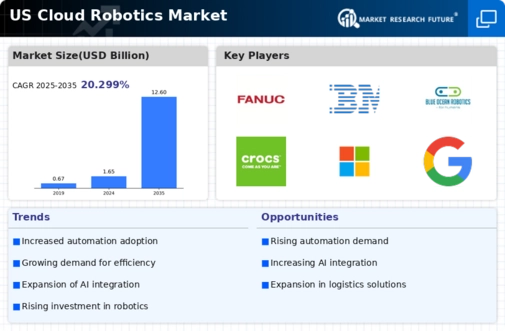Increased Investment in R&D
Investment in research and development (R&D) within the cloud robotics market is on the rise, as companies seek to innovate and improve their offerings. This influx of capital is fostering the development of new technologies and applications, particularly in sectors such as agriculture, logistics, and healthcare. In 2025, R&D spending in the robotics sector is anticipated to exceed $10 billion, reflecting a commitment to advancing cloud robotics capabilities. This focus on R&D is crucial for maintaining a competitive edge and addressing the evolving needs of various industries, thereby propelling the growth of the cloud robotics market.
Rising Demand for Automation
The cloud robotics market is experiencing a notable surge in demand for automation across various sectors. Industries such as manufacturing, logistics, and retail are increasingly adopting robotic solutions to enhance operational efficiency and reduce labor costs. According to recent data, the automation market is projected to grow at a CAGR of approximately 25% over the next five years. This trend indicates a strong inclination towards integrating cloud robotics into existing systems, allowing for real-time data processing and improved decision-making. As businesses strive to remain competitive, the cloud robotics market is likely to benefit from this growing demand for automation, which is seen as a critical driver for innovation and productivity.
Advancements in AI and Machine Learning
Technological advancements in artificial intelligence (AI) and machine learning are significantly influencing the cloud robotics market. These innovations enable robots to learn from their environments and improve their performance over time. The integration of AI with cloud robotics allows for enhanced data analysis and predictive maintenance, which can lead to reduced downtime and increased efficiency. The market for AI in robotics is expected to reach $15 billion by 2026, indicating a robust growth trajectory. As AI technologies continue to evolve, they are likely to drive the cloud robotics market forward, providing businesses with smarter and more adaptable robotic solutions.
Regulatory Support for Robotics Integration
Regulatory frameworks in the US are increasingly supportive of robotics integration across various industries, which is positively impacting the cloud robotics market. Government initiatives aimed at promoting automation and technological innovation are creating a conducive environment for the adoption of cloud robotics solutions. For instance, funding programs and grants for technology development are encouraging businesses to explore robotic applications. This regulatory support is expected to facilitate the growth of the cloud robotics market, as companies are more likely to invest in robotic technologies when they perceive a favorable regulatory landscape.
Growing Need for Remote Monitoring Solutions
The increasing need for remote monitoring solutions is driving the cloud robotics market, particularly in industries that require real-time data access and management. As businesses adapt to more flexible operational models, the demand for cloud-based robotic systems that facilitate remote monitoring and control is becoming more pronounced. This trend is particularly evident in sectors such as agriculture and manufacturing, where real-time insights can lead to improved productivity and resource management. The cloud robotics market is likely to see substantial growth as organizations invest in technologies that enable remote operations, enhancing their ability to respond to dynamic market conditions.

















Leave a Comment